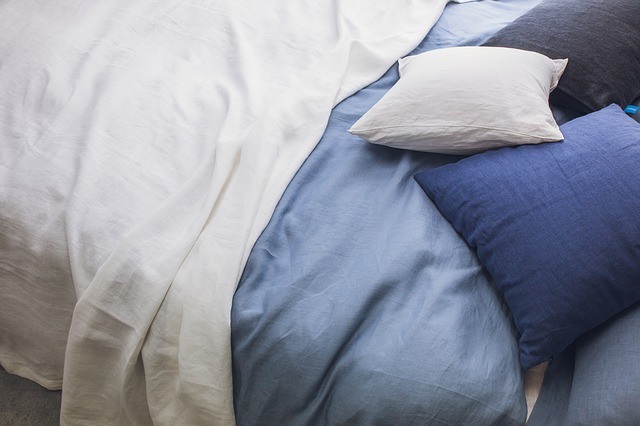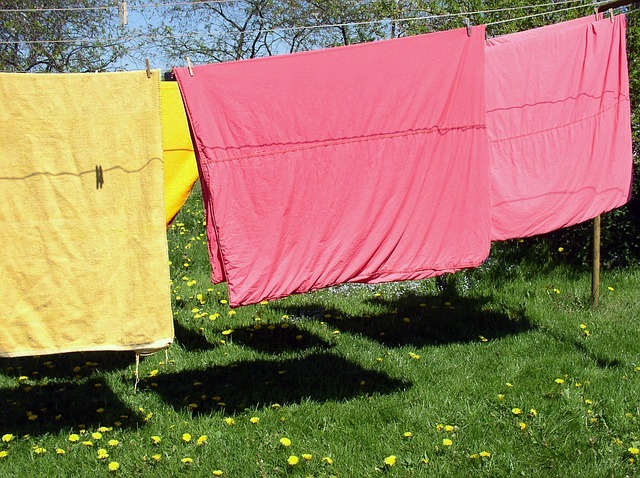Do you want to create your own duvet cover? How hard is it, and how does a duvet differentiate from a basic comforter?
Whether you place a duvet or a comforter over your sheets, there is no denying these simple, quilted, blanket-like bags of fluff easily make your bed a more comfortable and stylish haven to sleep in at night.

Both duvets and comforters can be filled with down, feathers, wool, or some alternative synthetic filling, and will ensure decorating and making your bed are all the easier.
The Difference Between Comforters and Duvets
While they both serve the same essential purpose, there is one key factor that differentiates the two. A comforter is typically just one of many pieces that you add to your bed to keep warm at night.
A duvet, on the other hand, is a single padded covering that can provide you with the same amount of warmth.
Duvets are also often wrapped up in an extra cover that will keep it from becoming stained, so you don’t have to wash it as often as other types of bedding.
How Hard is it to Make a Duvet Cover?
Making a duvet cover yourself is fairly simple. Because of all its straight seams and hidden raw edges, it’s considered an ideal novice sewing project.
Let’s take a look into how to sew a duvet cover, where to buy the right fabric for a DIY duvet cover, and several duvet cover ideas that will look perfect in your bedroom.
Where to Find Duvet Cover Patterns
If you’re looking for some inspiration for duvet cover patterns, look no further than The Spruce Crafts website.
They offer tons of brilliant crafting and sewing projects, including DIY duvet covers, for you to peruse and try out yourself!
ArchitectureArtDesigns.com is full of even more impressive DIY home improvement and home decorating ideas and keeps you up-to-date on all the latest home improvement fads and trends.
They’ve compiled a nice list of duvet cover patterns ranging from the purely elegant to the fun and chic, so you can sew this cover in whatever style you prefer!

Where to Buy Fabric for Duvet Covers
Duvet covers require extra wide fabric, which can be difficult and sometimes even impossible to find in most craft or quilting stores.
Luckily, there are quite a few stores and online shops that sell quality extra wide fabrics.
JoAnn Fabric and Crafts
You can’t go wrong with good, old JoAnn Fabric and Crafts. They carry just about every type of fabric there is – both in-store and online – in any color, pattern, or width you could possibly want.
They also offer many coupons for loyal customers, so if you’re a thrifty sewer, then you should have a blast stocking up on different fabrics and saving money while doing it.
Fabric.com
Fabric.com is another fantastic site that boasts a vast collection of extra wide fabrics, perfect for any duvet cover or other future sewing projects!
Warehouse Fabrics Inc.
Warehouse Fabrics Inc. has a huge variety of colorful, extra-wide sheeting and muslin fabrics available in widths as huge as 90 to 108 inches.
Keepsake Quilting
Though Keepsake Quilting is a store primarily full of quilting materials and backing, they also supply tons of fabric for other types of home decorating projects.

Inweave Fabric
Inweave Fabric has a huge selection of drapery fabrics, flannel fabrics, percale fabrics, and tablecloth fabrics available in dozens of great colors.
Which Fabric Should You Choose?
The best type of fabric to use for duvet covers is machine-washable cotton or cotton-linen blends. You should wash, dry, and iron these types of fabrics before beginning to pre-shrink it.
Quilting shops are typically the best places to look for these kinds of fabrics, as they carry tons of cotton in tiny prints, large prints, solids, and everything in between.
If you find that you just can’t resist the beautiful but pricy designs of designer bedding, then you should check to see if you can purchase two flat sheets from the line instead. That way, you can use the sheets to sew your own duvet cover for far less than it would cost to buy the entire duvet cover itself.
Most bedding manufacturers use the same fabrics for the sheets as they do in their duvets, so you would be working with pretty much the exact same quality material anyway.
Measurements
Unfortunately, the U.S. does not have strict standards for bedding or comforter sizes, which means that they will tend to vary based on the manufacturer.
It’s best to just measure the duvet you want to cover and use those numbers to calculate how big or wide you should make your personalized cover.
Ideal Sizes
Keep in mind that your cover should be no larger than the dimensions of your duvet. The ideal size is 2 to 3 inches (or 5 to 7.5 centimeters) smaller than your duvet, as this will ensure the cover will wrap around the duvet closely.
This prevents the materials from shifting around inside while you’re sleeping.
Trimming the Selvedges
Typically, most fabrics are not sold in widths large enough for a full duvet cover, so you will need to seam a few panels of fabric together to make the front and back.
You must double all the measurements you make to calculate the total amount of fabric you’ll need for the cover.

You should also trim off the selvedge edges of your fabric before you begin to sew. The selvedge edges on fabric are basically the finished edges on both sides of the material, which are a different texture and/or color from the rest.
Remember to subtract the selvedge edges from any measurements you take, all before you begin sewing your piece.
After you measure the width of your fabric without selvedge, place one full panel of fabric down the center of the duvet and two smaller panels to each side of it.
Make your smaller side panels as large as necessary to reach the desired width of your duvet cover. After this, add about one inch to the width of each panel for seam allowance.
For example, if the center panel needs to be 40 inches wide and each side panel needs to be 20 inches wide, cut the center panel 41 inches wide and the side panels 21 inches wide.
This allows those extra inches to be consumed by the seams.
This video shows an example of a DIY duvet cover.
How to Make a Duvet Cover
Now that you’ve found the right fabrics for your duvet cover and properly measured them out, it’s time to get sewing!
Supplies and Materials
- Approximately 10 yards of extra-wide fabric (though you can buy more just in case).
- Yardstick, long quilter’s ruler, or a tape measure.
- Sharp scissors.
- Straight pins.
- Sewing machine.
- Iron.
- Ironing board.
Steps
- If you haven’t already, take the time to carefully measure your duvet and the fabrics you plan to make the cover with. If you’re having trouble with this, take a look at this measurement chart.
- To make the front and back of the duvet cover, sew each side panel to its corresponding center panel. If you want a more professional-looking cover, try using French seams to sew them together. These seams are finished on both the inside and outside of the project, so no raw edges will unexpectedly poke up anywhere.
- Place two pieces of fabric together on their wrong sides. While you may usually sew the seams’ right sides together, do not do so in this case.
- Sew the seam with a 1/4-inch seam allowance. After that, trim away about 1/2 of that exact seam allowance. Make sure you do not cut too close to the stitches, as some extra give will be necessary to ensure no unraveling during its first trip through the washer.
- Iron the seam to one side. After that, fold at the seam so the right sides of the fabric are now facing together. Iron the seam closed.
- To avoid any potential shifting, pin the seam closed and sew it up again with a 1/4-inch seam allowance. Iron this seam again to one side.
- You can also apply a top stitch to tack down the flap if you want the cover to have a clean look. Just top stitch the right side of the cover alongside the French seam you just ironed. After that, stitch over the folded flap on the back. Iron this seam once again to smooth it out.
- Repeat steps 5-7 for all your panels to create a complete front and back section.
- Place the front and back sections together – with the wrong sides facing each other – pinning each side’s seam into place.
- Sew each side with French seams, as described in the steps above. Do not top-stitch these sides’ pieces.
- After sewing the sides in, sew the top closed with another French seam. The inside of the duvet should now be finished with no visible raw edges.
- Fold one inch of fabric to the inside of the cover and press to hem the bottom. Fold up another one inch and press again. After that, pin these folds into place.
- Stitch the hem close to the exterior fold line, and then again close to the interior fold line.

To Close the Bottom of Your Duvet
You can close up the bottom of your duvet with any of the following materials:
- Buttons and Buttonholes: This is one of the easier closing options, especially if you have a buttonhole attachment in your sewing machine.
- Sew-On Snaps: These are very easy to sew on by hand. Once you’ve finished attaching them, they’re quick to snap and unsnap whenever you need to clean the cover.
- Snap Fastener Kit: These no-sew kits can attach snaps to the bottom of your duvet cover and still give it a professional look. All you need is a hammer and the special attachment tool that should come in the set. Just be sure you read the instructions on this kit thoroughly before you use it.
- Ribbon or Twill Tape: You can tuck in 10-inch lengths of ribbon or twill tape under the folds of the hem before sewing it up.
- Zippers: You can easily purchase long zippers online, or visit your local craft store for a variety of zipper lengths. Use of a sewing machine is preferable, though attaching a zipper by hand is still doable with some patience. Just sew it up along the bottom for easy duvet coverage and removal.
Regardless of the material you choose to close up the bottom, just remember to sew it about every eight inches from the bottom.
This will help preserve existing seams and ensure the closure doesn’t rip by accident while you toss or turn.
Homemade Duvet Cover Ideas
Reversible
For those who are indecisive when it comes to the right kind of fabric, why not use differing material on the front and back of the duvet cover?
This reversible piece is just like having two different covers in one!
Upcycling
You can also save money by using new fabric on one side and an old sheet on the other, or by recycling two old sheets to make a simple duvet cover.
Matching Aesthetics
You can take inspiration from the bedroom this cover will become a part of. If you are making this cover for yourself, then look at the fabric of your pillows, sheets, or furniture with patterns you enjoy (such as seashells or flowers).
If you are making this cover for your child or grandchild, then maybe pick vibrant, soft fabrics with dinosaurs, fairies, or other types of patterns you know they may love.
Here’s an example of how to make a duvet cover for a toddler.
Conclusion
Duvet covers are comfortable, cozy, and so wonderfully practical. They make the perfect gift for anyone of any age, and they give an otherwise dull bedroom a bit of chic flair.
There are countless fabric options for DIY duvet covers and countless patterns listed online, so why not set aside a warm afternoon and try making a duvet cover today?
What’s your favourite DIY duvet cover pattern.
